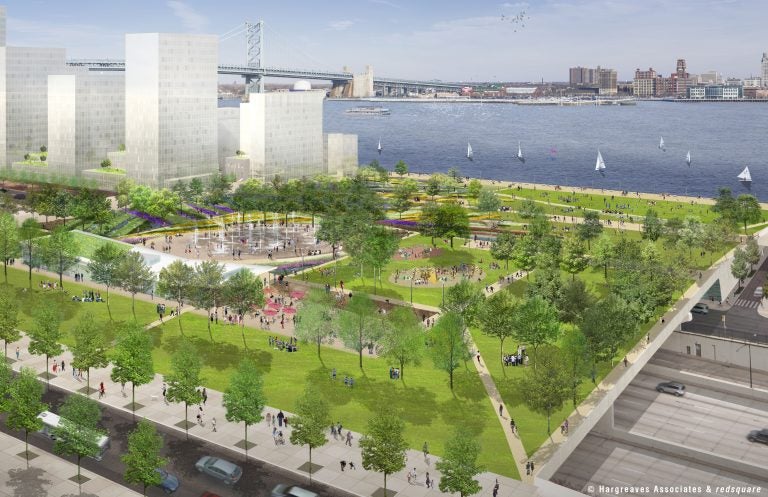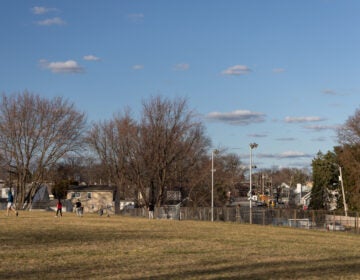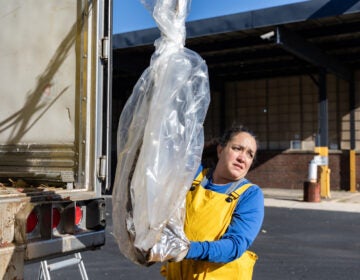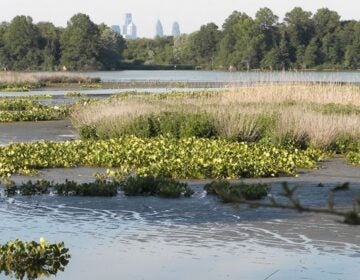Knight Foundation gives $4M for citywide conversation about park over I-95
A newly funded citywide public engagement campaign will be designed to give all Philadelphians a chance to shape plans for a new waterfront park over I-95 at Penn's Landing.

Plans for a new waterfront park over I-95 at Penn's Landing (Courtesy of Hargreaves Associates & redsquare)
This story originally appeared on PlanPhilly.
—
A newly funded citywide public engagement campaign will be designed to give all Philadelphians a chance to shape plans for a new waterfront park over I-95 at Penn’s Landing, project officials said Monday.
Supported by a $4 million grant from the John S. and James L. Knight Foundation announced on Sunday, the public engagement campaign will try to involve residents that don’t typically attend planning meetings and include outreach outside of the affluent Center City neighborhoods closest to the waterfront. The grant will go to the Delaware River Waterfront Corporation, the entity leading the $225 million effort to replace lanes of traffic with a new public destination.
“This is meant to bring that focus beyond the adjacent communities to ensure it really is a citywide asset,” said Joe Forkin, president of the DRWC. “How do we capture a person’s voice from across town, but who also has a desire and a right to be on the waterfront?”
It’s a particularly salient vision for a project that aims to cap a section of the highway that sliced through numerous riverfront neighborhoods with little regard for citizen protests. Knight Foundation officials said that’s the point.
“Not to get too poetic about it, but these kinds of projects are kind of healing the scars of urban renewal,” said Patrick Morgan, program director for Philadelphia at the foundation. “This is a way to not just rely on the project itself to do that [healing], but to rely on the process of a nimble and creative citywide conversation.”
The Knight Foundation also provides grant support to WHYY and PlanPhilly.
In Philadelphia, the construction of I-95 didn’t destroy any single neighborhood as urban renewal projects did in cities like New York and Baltimore. Instead, all the communities on the Delaware River, from South Philadelphia to the Northeast, were ripped up and cut off from the river.
“It was a very traumatic experience,” Mayor Jim Kenney told PlanPhilly last February when we broke the news of a $90 million budget allocation to cap the highway. “We lost a whole segment of our history that we’ll never get back, for a superstructure that will never go away. It’s time to mitigate that intrusion.”
The mitigation will take the form of 12 lush acres reconnecting Philly’s downtown core to the river, providing both public green space and buildable land for developers. The four-acre cap will run between Walnut and Chestnut streets and allow for a park that will include public amenities such as an ice skating rink and spraygrounds. Adjacent private development is expected to include 1,500 new homes, and 100,000 square feet of restaurants and entertainment uses.
The $225 million project will be funded with $90 million from the city, $15 million from the William Penn Foundation and $110 million from state and federal sources. State and foundation officials have committed to raising the final $10 million needed to complete the project.
When Kenney told PlanPhilly about the plan in 2017, he spoke about providing a slice of waterfront accessible by mass transit and affordable for families who can’t decamp the city for the Jersey Shore.
Recent research has shown that the people who turn out for community meetings are often whiter than the rest of the population, more affluent, more likely to be homeowners, and more likely to oppose new development.
Asked how the DRWC is going to ensure that doesn’t happen here, Forkin said the agency isn’t 100 percent sure yet — but that’s where the $4 million comes in.
“That’s how we can reach folks who aren’t just the typical people who show up to zoning meetings,” said Forkin. “This Knight investment allows us to use different techniques that might not come out at a traditional community meeting.”
WHYY is your source for fact-based, in-depth journalism and information. As a nonprofit organization, we rely on financial support from readers like you. Please give today.







